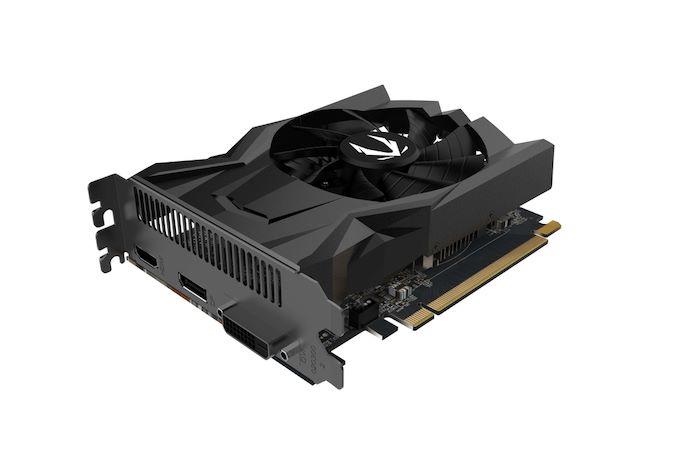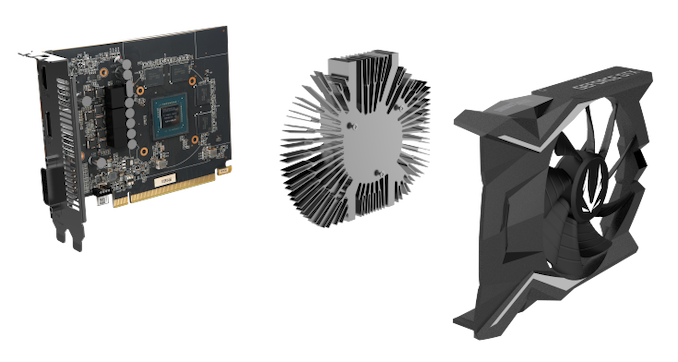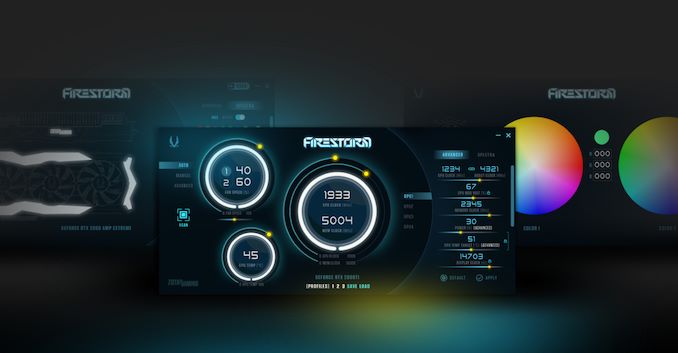The NVIDIA GeForce GTX 1650 Review, Feat. Zotac: Fighting Brute Force With Power Efficiency
by Ryan Smith & Nate Oh on May 3, 2019 10:15 AM ESTMeet The ZOTAC GAMING GeForce GTX 1650 OC
In what's becoming a theme of the GTX 16-series, the GeForce GTX 1650 is once again a pure virtual launch, where NVIDIA is not going for any Founders Edition models and all cards are up to their add-in board partners. For today's review, we take a look at ZOTAC's GeForce GTX 1650 OC, a diminutive 2-slot single-fan card with reference base clockspeed and mildly overclocked boost clock. With a TDP of 75W, the card pulls all its power from the slot, with is typical for most GeForce GTX xx50 parts.
| GeForce GTX 1650 Card Comparison | ||||
| GTX 1650 (Reference Specification) |
ZOTAC GTX 1650 GAMING OC | |||
| Base Clock | 1485MHz | 1485MHz | ||
| Boost Clock | 1665MHz | 1695MHz | ||
| Memory Clock | 8Gbps GDDR5 | 8Gbps GDDR5 | ||
| VRAM | 4GB | 4GB | ||
| TDP | 75W | 75W | ||
| Length | N/A | 5.94" | ||
| Width | N/A | 2-Slot | ||
| Cooler Type | N/A | Open Air | ||
| Price | $149 | $149 | ||
At just under 6", the Zotac GTX 1650 OC is compact enough most builds. As the card pulls power only from the PCIe slot, it's a conventional fit for mITX and other SFF builds, or simply as a no-fuss drop-in replacement. In turn, the Zotac GTX 1650 OC's cooling solution is one they've used before with their other mini ITX cards, combining a 90mm fan and 'sunflower' heatsink. This also provides headroom for ZOTAC to put a modest boost increase of 30MHz.
The design/shroud and output situation is likewise similar. One DVI port, one HDMI 2.0b port, and one DisplayPort covers all bases, including potential HTPC use. Of course, partners can always decide on different configurations but the power/cost-sensitive entry-level range is essentially standardized. VirtualLink is naturally not included here for several reasons, and in perspective the 30W USB-C controller power budget for VirtualLink would be 40% of the overall 75W TDP.
For overclocking and tweaking, ZOTAC has their in-house Firestorm utility updated for Turing, including support for auto-OC scanning as part of Turing's GPU Boost 4 technology.














126 Comments
View All Comments
nevcairiel - Saturday, May 4, 2019 - link
A P-Frame (Predictive Frame) by definition is only in one direction - backwards. B-Frames (Bidirectional Predictive Frame) are allowed in both directions. This is an import distinction because it matters in which order those frames are put into the encoded video. "Future" frames of course need to be send first, or you can't use them for prediction.Thats where pattern like "IPBBB" come from. You start with a single I frame, a single P frame referencing that I frame (the P might be shown after some B frames), and then an array of B frames that reference both the I and P frames - and possibly each other.
P and B frames are otherwise identical in how they work. Both contain motion vectors and entropy data to correct the interpolation.
Also note that H264 already supported up to 16 reference frames for interpolation. Its called bidirectional not because its two frames, but two directions - past and future.
Opencg - Friday, May 3, 2019 - link
please include fortnight average fps over 10 hour playtime. for all cards. all on the same patch. thxBulat Ziganshin - Friday, May 3, 2019 - link
The "NVIDIA is holding back a bit" part is duplicated on pages 1 and 2Ryan Smith - Friday, May 3, 2019 - link
Whoops. That was meant to get excised when I rearranged the article. Thanks!eva02langley - Friday, May 3, 2019 - link
This card shouldn't exist.R7 was making sense because it was cheaper than a 2080, however this is more expensive than a RX 570... AND WEAKER!
Oxford Guy - Saturday, May 4, 2019 - link
It apparently exists for the GTX 960 buyers (the people who don't do their homework).eek2121 - Friday, May 3, 2019 - link
In before 1650ti. ;)AshlayW - Friday, May 3, 2019 - link
Wow. This card makes no sense. Go watch hardware unboxed's video where he conveniently shoots down the "power efficiency" argument. It's a load of rubbish, there is absolutely no reason to buy this card over even the 4GB 570, for any new gaming build. This review tried so hard to paint this turd in a positive light, continually underscoring AMD's "technological disadvantages" and "thin profit margin". P20 isn't even that much bigger than TU117 also.I'm sorry I just feel it is too friendly to nvidia and doesn't criticize this terrible product pricing enough. RX570 8GB pulse, fro sapphire is cooler running, quieter, vastly higher build quality, >10% faster, twice the vram and 135W board power, which is perfectly fine even for potato OEM builds anyway.
Seriously, drop Ty efficiency arguy. This card is DOA at 149 because 570 killed it.
1024 CC card at 130 bucks would've been passable, not this joke.
AshlayW - Friday, May 3, 2019 - link
The 570 8Gb pulse is also the same price or cheaper than 1650, at least here in the UK. Forgot to mention that important point.AshlayW - Friday, May 3, 2019 - link
Typos as I'm on my phone and I have fat fingers.Should read: "drop the efficiency argument"